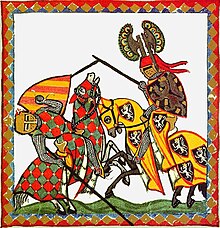Blades (noble family)
Klingen (also Barons von Klingen , Hohenklingen , Alten-Klingen and Klingnau ) is the name of a noble family from the canton of Thurgau in Switzerland that was important in the Middle Ages .
origin
Altenklingen
The ancestral home of the Lords of Klingen was Altenklingen Castle near Wigoltingen in Thurgau. The castle was built around 1200 and was inhabited by the family until 1395. The village of Klingenzell and the Feldbach monastery were founded by the family. From the 11th century to 1395, the barons of Klingen exercised the lower jurisdiction of Märstetten and Illhart as well as jurisdiction over Wigoltingen for the Konstanz cathedral chapter . The von Klingen family died out in 1395 after several of them died in 1386 as soldiers at the side of Leopold of Austria at the Battle of Sempach .
The later statement that St. Wiborada , a female hermit near St. Gallen, who was slain in the year 925 during the invasion of the Hungarians , is said to have come from the house of the Lords of Klingen is more legendary .
Klingnau and Wehr
Ulrich II von Klingen (documented 1227–1248) married Ita von Tegerfelden , the heir to extensive estates on both sides of the High Rhine in Aargau and in southern Baden. In 1239 he built the Klingnau Castle there and founded the city of the same name. Werrach Castle in Wehr also belonged to his property . The Castle Tegerfelden was already at 1,269 ruin.
The sons Walther and Ulrich shared the inheritance around 1251: Walther von Klingen , who became known as a minnesinger , received the property on the Upper Rhine, his brother Ulrich the rule Altenklingen, a younger brother joined the Johanniterkommende Leuggern , in 1270 he is as whose commander is documented. In 1254 the brothers settled a commander who had been settled from Leuggern in Klingnau. Walther founded the Dominican convent Klingental in Wehr in 1256, which was moved to Kleinbasel around 1272, where he was later buried. Unlike his father, who was close to the Kyburgers , Walther leaned against Count Rudolf von Habsburg , who was elected king in 1273, during the interregnum . Walther's three sons had died before 1260. Walther and his wife then made various spiritual foundations. In 1269 Walther sold the town and castle of Klingnau to the bishopric of Konstanz , but stayed in the north wing of the castle until the 1280s, before moving to Strasbourg and finally to Basel. Werrach Castle came to Rudolf von Habsburg in 1273.
Hohenklingen
Walter von Klingen, castvogt of the St. Georgen monastery in Stein am Rhein, built a residential tower around 1200 from which Hohenklingen Castle developed. At the beginning of the 14th century the line of those von Hohenklingen divided into the branches Hohenklingen- Brandis and Hohenklingen- Bechburg . In 1359 Ulrich and Walter von Hohenklingen-Brandis sold their share of the castle and the castvogtei to Austria and received them back as a fief . In 1419 their descendants sold the fiefdom to Kaspar von Klingenberg , lord of the Hohentwiel Fortress , who in 1433 also bought the other half of Hohenklingen.
coat of arms
Blazon : The family coat of arms shows a gold-crowned and red-tongued upright silver lion in a black shield sprinkled with silver shingles; on the helmet with its silver-black blankets sits a growing, gold-crowned and red-tongued silver lion, at the back with a notched red umbrella board, the tips of which are decorated with peacock feathers.
The coat of arms of the blades in the Codex Manesse also shows the silver lion on black, but the shingles are gold; on the helmet with red helmet covers two outwardly swept silver (iron) axes; the edges of the ax blades are equipped with peacock feathers.
After the division of the sexes around 1225, the von Hohenklingen branch chose its own coat of arms. It shows a five-leaf oak branch on a golden background and a red disc framed with white scales as a crest ornament.
Coat of arms of Walther von Klingen in the Codex Manesse (approx. 1300–1340)
Coat of arms of the clings in the Zurich coat of arms roll (approx. 1340)
Coat of arms of the (Hohen-) Clingen (1225) in the Zurich coat of arms roll (approx. 1340)
Significant namesake
- Fides von Klingen († 1358), princess of the Fraumünster monastery in Zurich
- Walther von Klingen († 1286), minstrel
literature
- Walther von Klingen and Klingental Abbey to Wehr . Jan Thorbecke Verlag, 2010, ISBN 978-3-7995-0850-6 .
- Franz Josef Mone: The former Sanktblasian office of Klingenau. In: Journal for the history of the Upper Rhine. Part 1.
- Wilhelm Wackernagel : Walther von Klingen, founder of the Klingenthal and minstrel. Basel 1848.
- JA Pupikofer: History of the barons of Alten-Klingen, Klingnau and Hohenklingen. In: Thurgauian contributions to patriotic history. Volume 10. (in Google Book Search)
Web links
- Martin Leonhard: blades, from. In: Historical Lexicon of Switzerland .
- Sound. In: Julius Kindler von Knobloch: Upper Baden gender book. Volume 2, Heidelberg 1905, pp. 297-299.
- Coat of arms of the Zollikofer von Altenklingen (St. Gallen)
Individual evidence
- ↑ Christopher Schmidberger: Unequal friend or vassal? The personal relationship between Walther von Klingen and Rudolf von Habsburg , In: Walther von Klingen , anthology, ed. vd Stadt Wehr, Ostfildern 2010, pp. 23–46.
- ↑ Erich Beck, The Burgen Klingnau and Wehr as seats of the noble sex of those von Klingen - considerations on their role in the exercise of power , in: Burgen und Schlösser , Zeitschrift für Burgenforschung und Denkmalpflege, ed. from the European Castle Institute of the German Castle Association , 4/2015, pp. 249–258








